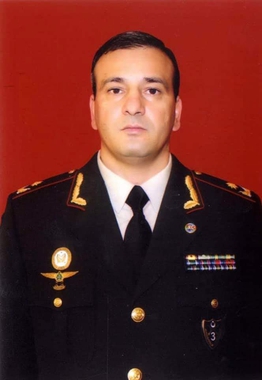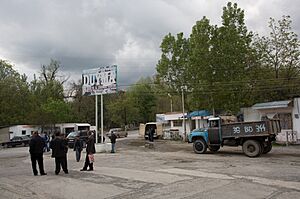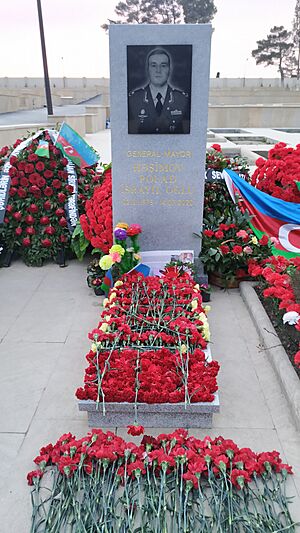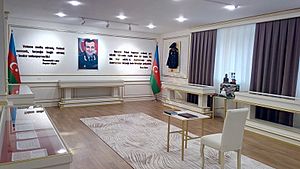Polad Hashimov facts for kids
Quick facts for kids
Polad Hashimov
|
|
|---|---|
 |
|
| Nickname(s) | General of the Trenches |
| Born | January 2, 1975 Vandam, Gutgashen District, Azerbaijan SSR, Soviet Union |
| Died | July 14, 2020 (aged 45) near Tovuz District, Azerbaijan |
| Buried |
Second Alley of Honor
|
| Allegiance | |
| Service/ |
|
| Years of service | 1992–2020 |
| Rank | Major general |
| Commands held |
|
| Battles/wars |
|
| Awards | Gold Star Medal (posthumous) |
| Alma mater |
|
| Spouse(s) | Ophelia Salmanova |
| Children | three |
Polad Israyil oghlu Hashimov (born January 2, 1975 – died July 14, 2020) was a brave Azerbaijani military officer. He became a major general and was named a National Hero of Azerbaijan. He served as a high-ranking officer in the Azerbaijani Armed Forces, helping to lead the 3rd Army Corps.
Hashimov was a well-known military leader. He fought in the First Nagorno-Karabakh War and the Four-Day War. He received many awards during his time in the military. In July 2020, he led Azerbaijani forces during border clashes with Armenia. He was killed on July 14 while fighting in the Tovuz District of Azerbaijan.
His death led to large protests across Azerbaijan. People called for stronger action against Armenia. This event was a step towards the 2020 Nagorno-Karabakh war that started later that year. In December 2020, he was given the title of National Hero of Azerbaijan after his death.
Hashimov is the first and only general in the Azerbaijani Armed Forces to be killed in battle. Before him, two other high-ranking officials were killed in 1991 when their helicopter was shot down.
Contents
Early Life and Education

Polad Israyil oghlu Hashimov was born on January 2, 1975. His birthplace was Vandam in the Gutgashen District of the Azerbaijani SSR. At that time, this area was part of the Soviet Union.
His father, Israyil, worked at an aluminum plant in Sumgayit. He was a metallurgist, which means he worked with metals. His mother, Samaya, also worked at the same plant. Hashimov's grandfather, Mikayil, fought in World War II. He named Polad "Polad," which means "steel" in Azerbaijani. In July 1976, when Polad was six months old, his family moved to Sumgayit.
Polad started school in Sumgayit in 1982. He later attended Secondary School No. 34, named after Mikayil Mushfig. He was very good at mathematics during his school years.
Even though he wanted to be a lawyer, Hashimov decided to join the military in 1992. This was during the First Nagorno-Karabakh War. With his father's permission, he joined the Baku Higher Combined Arms Command School. He graduated in 1995 with a degree in motorised infantry. In 1994, he went to Turkey for a three-month military training course. In 2014, he studied at the Azerbaijan Higher Military Academy. He earned a master's degree in military leadership in 2016.
Military Career
Fighting in the First Nagorno-Karabakh War
In November 1992, during the First Nagorno-Karabakh War, Hashimov was training with the 702nd Motorised Rifle Brigade. He helped defend the villages of Marzili and Novruzlu in the Aghdam District of Azerbaijan. He also took part in Operation Murovdagh in February 1994. He fought against Armenian forces in the Murov mountain range.
After the war ended with the Bishkek Protocol, Hashimov continued to serve in military units. These units were stationed on the front line of the ongoing conflict. For many years, he commanded military units in different areas like Barda and Shamkir. From 1995 to 2017, Hashimov held many different roles. He was promoted to major in 2003 and to lieutenant colonel in 2009.
The Four-Day War
On April 1, 2016, heavy fighting started between Azerbaijani and Armenian forces. This event is known as the Four-Day War. During these clashes, Hashimov was a Deputy Commander and Chief of Staff of the 1st Army Corps. He led Azerbaijani forces in the Tartar District.
His forces moved towards Talish during night operations. They captured several important locations. Hashimov was wounded during these battles. One military post he took near Talish was later named "Polad" in his honor.
After a ceasefire was agreed, Hashimov wanted to resign. However, the president of Azerbaijan, Ilham Aliyev, did not allow him to leave the army.
In 2017, Hashimov became Deputy Commander and Chief of Staff of the 3rd Army Corps. On June 24, 2019, President Aliyev promoted Hashimov to major general. This is the highest military rank in the Azerbaijani Army. Hashimov was the first general from the Gabala region since Ismayil bek Kutkashensky, a military officer from the 1800s.
Tovuz Clashes
On July 12, 2020, small battles broke out on the border between Armenia and Azerbaijan. These clashes mainly happened in the Tavush Province of Armenia and the Tovuz District of Azerbaijan.
Hashimov led the Azerbaijani forces during these clashes. In the first hours, three Azerbaijani soldiers were killed and four were wounded. The fighting continued the next day with artillery and drone attacks. Azerbaijani officials said their forces had "neutralized" many Armenian soldiers and destroyed military targets. In total, at least 17 military personnel and one civilian were killed during these battles.
Death and Funeral

More fighting happened during the night and morning of July 14. That morning, seven Azerbaijani soldiers were killed, including six officers. On the same day, Azerbaijan's deputy defense minister announced that Hashimov and Colonel Ilgar Mirzayev were among those who died.
Hashimov is the first and only general in the Azerbaijani Armed Forces to be killed in military operations.
Funeral and Public Reaction
On July 14, Hashimov's body was taken to Vandam and then to Sumgayit, where he lived. He was buried next to Colonel Mirzayev on July 15. The burial took place in the Second Alley of Honor in Baku. Many important officials attended the funeral. President Ilham Aliyev spoke with Hashimov's mother by phone to offer his condolences.
Hashimov's death made many people in Azerbaijan very upset. Some people believed that his location was given to the Armenian side by a spy. This led to large protests across the country.
When Hashimov's body arrived at his home in Sumgayit, hundreds of people gathered. They chanted slogans supporting the army. The protests spread to Baku, with about 50,000 people taking part. They marched to Freedom Square and then towards the Martyrs' Lane. Protesters waved the Azerbaijani flag. They called for an end to the COVID-19 quarantine and for a war against Armenia to take back the Nagorno-Karabakh region. Smaller rallies also happened in other cities during the burials of fallen soldiers.
A smaller group of protesters reached the National Assembly building on the night of July 14-15. They supported the army and called for war. They also demanded that some high-ranking military officials resign. Some protesters broke into the National Assembly building, causing damage. Security forces later removed them. The Azerbaijani Ministry of Internal Affairs said that protesters attacked police officers. Several police officers were injured, and police cars were damaged. Security forces used water cannons and tear gas to break up the crowd.
The protests are thought to have played a role in the start of the 2020 Nagorno-Karabakh war in September of the same year.
Personal Life
Hashimov had three siblings: Arzu, Kamala, and Ilham. He married Ophelia Salmanova on September 5, 2003. They had three children: Davoud, Teimour, and Aybaniz.
Hashimov was a popular figure in Azerbaijani society. Soldiers and officers respected him greatly. He received an apartment for his service during the Four-Day War. However, Hashimov lived in a rented apartment and gave his new apartment to the family of a fallen Azerbaijani soldier.
Legacy

After Hashimov's death, "Polad" became a very popular name for newborn boys, especially in the Gabala District.
In August 2020, two books about Hashimov were published. One was called Our Steel General. The other, General Polad Hashimov in Memories, included stories from his mother, wife, daughter, and colleagues.
After his death, Azerbaijani singer Chingiz Mustafayev released a song called I'm Like My Homeland. It was dedicated to Hashimov and other fallen soldiers. Another military singer, Shamistan Alizamanli, released a song called My Pasha, Hey! also dedicated to Hashimov. A documentary called 7 Moments of Polad was shown on Ictimai TV.
In August 2020, a street in his hometown of Vandam was named after Hashimov. In January 2021, streets were also named after him in Guba, Azerbaijan, and in Keban, Turkey. A park named after him opened in Bursa, Turkey, in October. On May 7, 2021, a street in Baku was renamed Polad Hashimov Street.
Hashimov was declared a National Hero of Azerbaijan in December 2020. This honor was given by President Aliyev after his death.
Awards
Throughout his military career, Hashimov received many promotions and more than twelve awards. In April 2021, the Iranian embassy in Azerbaijan visited Hashimov's family. They posthumously awarded Hashimov the World Sacrifice Award. However, Hashimov's mother refused to accept this award.
 (2001) — Jubilee medal "10th anniversary of the Armed Forces of the Republic of Azerbaijan".
(2001) — Jubilee medal "10th anniversary of the Armed Forces of the Republic of Azerbaijan". (2002) — Medal "For impeccable service" III degree.
(2002) — Medal "For impeccable service" III degree. (2003) — For military services medal.
(2003) — For military services medal. (2008) — Jubilee medal "90th anniversary of the Armed Forces of the Republic of Azerbaijan".
(2008) — Jubilee medal "90th anniversary of the Armed Forces of the Republic of Azerbaijan". (2004) — Medal "For Distinguished Service" III degree.
(2004) — Medal "For Distinguished Service" III degree. (2006) — Medal "For Distinguished Service" II degree.
(2006) — Medal "For Distinguished Service" II degree. (2007) — Medal "For impeccable service" II degree.
(2007) — Medal "For impeccable service" II degree. (2009) — Medal "For the Fatherland".
(2009) — Medal "For the Fatherland". (2012) — Medal "For impeccable service" I degree.
(2012) — Medal "For impeccable service" I degree. (2013) — Jubilee medal "95th Anniversary of the Armed Forces of Azerbaijan".
(2013) — Jubilee medal "95th Anniversary of the Armed Forces of Azerbaijan". (2014) — Order "For service to the Fatherland" III degree.
(2014) — Order "For service to the Fatherland" III degree. (2016) — Order "For service to the Fatherland" II degree.
(2016) — Order "For service to the Fatherland" II degree. (2017) — Medal "Veteran of the Armed Forces of the Republic of Azerbaijan".
(2017) — Medal "Veteran of the Armed Forces of the Republic of Azerbaijan". (2018) — Jubilee medal "100th anniversary of the Azerbaijani Army".
(2018) — Jubilee medal "100th anniversary of the Azerbaijani Army". (2020) — National Hero of Azerbaijan (posthumously).
(2020) — National Hero of Azerbaijan (posthumously). (2020) — Gold Star Medal (posthumously).
(2020) — Gold Star Medal (posthumously).- World Sacrifice Award (posthumously; given by Iranian embassy; refused)
See also
 In Spanish: Polad Hashimov para niños
In Spanish: Polad Hashimov para niños

